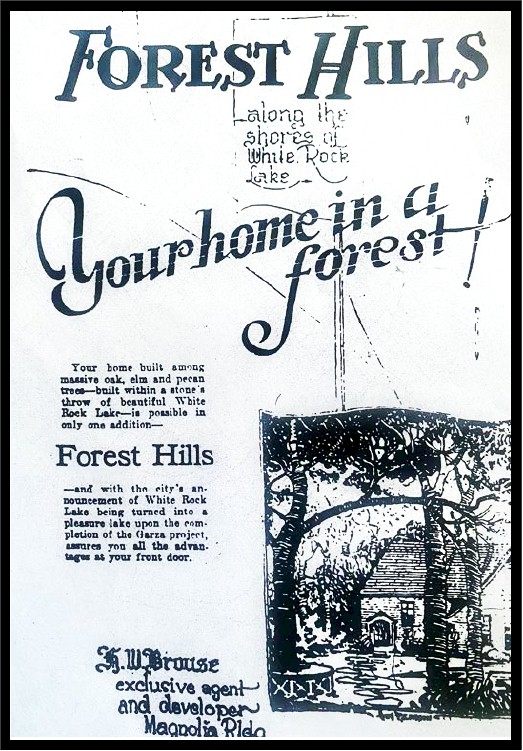Forest Hills History – Origins
Located within Forest Hills at the northwest corner of St. Francis Avenue and San Leandro Drive is the Warren Angus Ferris Cemetery. About all that remains of the cemetery that can be seen today is its Texas Historical Marker. This cemetery was used to bury the Ferris family and other early inhabitants during the nineteenth and early twentieth centuries.

Warren Angus Ferris is an important figure in early Dallas County history and Forest Hills. He was born in 1809 and spent much of his boyhood in New York State. As a young man, he left home for the West and spent time exploring and surveying the Rocky Mountains. He was the first to record the marvels of Yellowstone National Park and produced several writings on his explorations. His involvement with Texas dates to 1836 when he was associated with the writing of the Texas Declaration of Independence. He is also reported to have been a Captain in the Texas army at the Battle of San Jacinto. In 1837, was elected surveyor of Nacogdoches County, and this work brought him to the Dallas area. In 1840, Ferris camped on the banks of White Rock Creek and began surveying what is today Dallas County. His field notes record the arrival of John Neely Bryan who camped on the banks of the Trinity River and would found the City of Dallas in 1841.
For more information on Warren Angus Ferris and Warren Ferris Cemetery, visit
friendsofthewarrenferriscemetery.org
Unlike the streets of many cities which tend to run north-south and east-west, Ferris generally followed the directions of the local streams and rivers in his surveys of the Dallas area. Hence, the northeast-to-southwest orientation of the streets in downtown Dallas.
Ferris selected a 640 acre tract of land to homestead in 1845. The Ferris Farm would later become most of what is known today as Forest Hills. In 1847, Ferris began to use the northwest corner of his property for a cemetery, with the first recorded burial being that same year and the last in 1906. Approximately 100 individuals were buried there including Warren Ferris, his wife and several of his children.
Frances Moore Ferris, W.A. Ferris’s second wife died April 23, 1869, two weeks after having her 13th child in 20 years of marriage. Her will stipulated that if Warren Ferris died before 1874 (he died in 1873) that her children could not sell their share of the land until 1874. William and Walter Caruth acquired the land through the Ferris’s debts and purchase in 1874 and 1875 and later sold the land to Wayne and Annie Gates. Wayne and Annie Gates sold the land to Leon Fechenbech on May 28, 1923.
In April 1924, Leon L. Fechenbach dedicated the plat of the Forest Hills Addition, six miles from the city limits of Dallas. Leon L Fechenbach owned the land and H.W. Brouse was the developer. “From early 1923 to August 1927, I sold as an exclusive agent, more than $500,000 worth of home sites.” H.W. Brouse – April 8, 1928 Dallas Morning News.
The land was bounded by Garland Road (old Bankhead Highway); Lakeland Drive (old John West Road); the Santa Fe Railroad tracks; Highland Road (then called Wilshire Blvd.); and one block of San Rafael Drive.
An advertisement in the November 30, 1924, Dallas Morning News shows an English Tudor house with the headline, “Your home in a forest!” Describing the area: “Your home built among massive oak, elm, and pecan trees—built within a stone’s throw of beautiful White Rock Lake—is possible in only one addition—FOREST HILLS—and with the city’s announcement of White Rock Lake being turned into a pleasure lake upon the completion of the Garza project, assures you all the advantages at your front door.” Visit the Timeline to 100 for more advertisements, plot and maps during this period.
Being about five miles from downtown Dallas, Forest Hills was truly in the country and one of the few areas around White Rock Lake that was wooded. White Rock Lake itself was constructed in 1911 as Dallas’ first water reservoir, later becoming a city park in 1929.
Forest Hills was annexed into Dallas in May 1945.
Forest Hills today is a quiet, tree-shaded area of homes without the feeling of being within the large bustling city that is Dallas. Its residents can be seen throughout the neighborhood, walking, running and bicycling, and generally enjoying this unique oasis of calm in the city.

